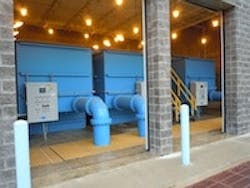Illinois Wastewater Treatment Plant Expanded To Accomodate Community Growth
The Caseyville wastewater plant in Caseyville, Ill., started its service in 1968 with a traditional flow through activated sludge system (extended aeration). Since that time, several expansions and upgrades have been needed to accommodate the community’s rapid growth and treatment requirements for ammonia, nitrogen and total suspended solids (TSS). The latest expansion took place in 2008 with new secondary and tertiary treatment technologies.
Solution
The plant chose a four-basin AquaSBR sequencing batch reactor (SBR) system followed by three AquaDisk cloth media filters to handle an average design flow of 2.2 million gal per day (mgd). The AquaSBR system was originally selected for its relatively small footprint in comparison to the other competing technologies (oxidation ditch, extended aeration, etc.), but other valuable features were soon realized by the plant operators from both process and mechanical perspectives. The SBR process is operated in parallel with the existing extended aeration process and provides direct decant to the AquaDisk filters without the need for a post-equalization basin. The whole plant’s primary treatment focus is the removal of ammonia nitrogen and TSS, and although not required, the plant achieves low total nitrogen and phosphorus.
Results
The AquaSBR system processed 120% of the maximum design flow within two months of startup while still meeting permit requirements. Although not required in the current effluent-discharging permit, the AquaSBR system also provides better phosphorus removal in comparison to the parallel extended aeration system. The SBR system is achieving less than 1 mg/L total phosphorus without chemical addition, while the extended aeration plant uses alum addition to achieve 2 to 3 mg/L total phosphorus. Average operating data for January to June 2011 is shown in Table 1.
The AquaDisk cloth media filters allow higher hydraulic and solids loading rates than conventional granular media, resulting in a smaller footprint. For Caseyville, the advantage of land space savings from Aqua-Aerobic technologies was fully exploited.
Together with its consistent operational performance, the plant superintendent, Joe Hogg, said, “We are very satisfied with the AquaSBR and AquaDisk filter operations and results.The systems are doing an excellent job. If I had to do it all over again I would."
Rungrod Jittawattanarat is project application engineer for Aqua-Aerobic Systems Inc. Jittawattanarat can be reached at [email protected].
